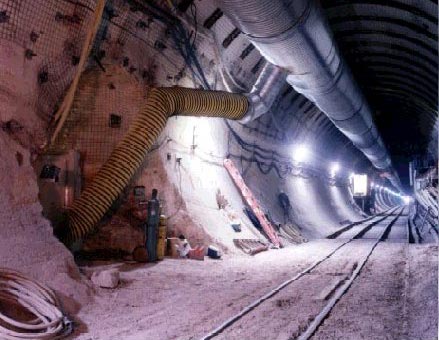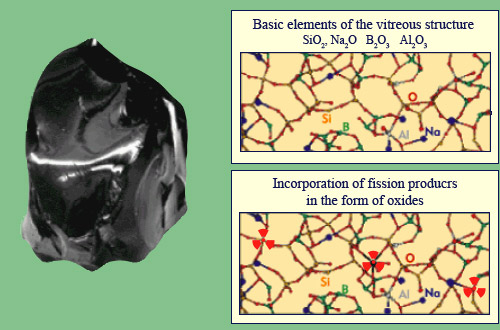Containment and burial when it is not enough to wait
Letting time do its work is not sufficient once radioactive decay has slowed down. To put out of reach any residual radioactivity that would persist into the distant future, the solution remains of immobilising the radioactive atoms – which are not proliferating – and screening off these atoms from the living world.

Burial in a deep repository
Access gallery at the Yucca Mountain site in the Nevada Desert, USA. The construction of this underground storage site, which would have housed the accumulated waste from American nuclear power plants, was halted in 2011 for mainly political but also technical reasons.
© DOE
A sheet of paper stops alpha rays . A metal wall a few millimetres thick is enough to stop beta electrons
. A metal wall a few millimetres thick is enough to stop beta electrons , but gamma rays
, but gamma rays require much greater screen thicknesses. The ‘attenuation length’, the screen thickness necessary to attenuate the intensity of gamma rays by a half, is around ten centimetres for water. It drops to 1 or 2 cm for highly absorbent materials like lead. Lead blocks, or several metres of earth or water, provide effective protection against gamma radiation, and therefore the other types of radiation too.
require much greater screen thicknesses. The ‘attenuation length’, the screen thickness necessary to attenuate the intensity of gamma rays by a half, is around ten centimetres for water. It drops to 1 or 2 cm for highly absorbent materials like lead. Lead blocks, or several metres of earth or water, provide effective protection against gamma radiation, and therefore the other types of radiation too.
Efforts are therefore made to contain the radioactivity in a package consisting of a solid material, known as the ‘matrix’, capable of incorporating the radioactive atoms and preventing their migration. These atoms behave like ordinary atoms when they are not decaying. However, their decay produces heat and causes damage within the matrix. This heat has to be removed for as long as necessary and a material has to be chosen that is resistant to radiation.

Trapping radioactive atoms in glass
The above diagram shows the capacity of a vitreous amorphous structure, to absorb a large quantity of chemical species (silicon, boron, sodium, aluminium, oxygen, etc.) under normal circumstances. Special types of glass (left), like those used at La Hague, are also designed to incorporate the wide variety of elements present in spent fuel. Fission products and actinides are incorporated and form chemical bonds with the main components of the glass, which hold them captive.
© CEA/DCom
The packages are stored for as long as it takes for the release of heat to fall to a reasonable level, in a pool or in the open air, above ground or at shallow depths. This also allows any decisions about the final destination of the packages to be put off, and offers the possibility of changing one’s mind – research progress permitting – if better solutions were to become available.
Once the packages are sufficiently cool, it is generally the case that they will be buried deep down in concrete structures. Unless they were given a helping hand by a volcanic eruption… or by humanity, these vitrified packages could not be raised from 500 metres underground by the Devil himself! Geological strata are therefore sought that are stable and free from water.
Water is the only abundant agent capable of attacking the packages, dissolving the soluble matter and bringing the radioactive elements back up to the surface. If the geological stratum is dry and the package is designed to be water-resistant, the package’s return to the surface will be only slow and gradual, diluted by time and space.
The purpose of research into geological strata and packages is to understand the mechanisms that would cause the package to rise, so as to reduce the risk of this happening. The research has already demonstrated the feasibility of disposal repositories. A number of futuristic projects also exist: some Americans suggested drilling boreholes several kilometres deep on the site of reactors, for burying their waste; sending the waste into space has been suggested, but this is too dangerous and costly, and remains within the realm of science fiction.
Other articles on the subject « Waste strategies »
Slow disappearances
Trapping radioactivity until it disappears A scenario for the long-term future of the waste It wi[...]
Oklo : a natural reactor
Nature at work over the last two billion years It was noticed by chance in the 1970s that a urani[...]
Diluting radioactivity
A practice for elements with low levels of toxicity Management of radioactive waste generally foc[...]
Conditioning
Packages for trapping radioactivity… Conditioning means containing the radioactivity and im[...]
Temporary storages …
Storing: a useful but temporary solution Storing means tidying an object away with the intention [...]
Deep geological disposal
Ground-level and deep disposal: a definitive solution Deep disposal of the most radioactive waste[...]
Separating and sorting
Sorting radioactive waste has advantages As with household waste, sorting can prove really useful[...]
Destroy (transmutation)
Transforming radioactive nuclei to make them less troublesome… The incineration of househol[...]
What to transmute?
Transmuting long-lived actinides and fission products Long-lived elements: actinides and fission [...]
Transmuting actinides
Attractive in principle, difficult in practice Destroying actinides using fission reactions is at[...]